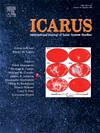A Pyroxenite mantle on Mercury? Experimental insights from enstatite chondrite melting at pressures up to 5 GPa
IF 2.5
2区 物理与天体物理
Q2 ASTRONOMY & ASTROPHYSICS
引用次数: 0
Abstract
Enstatite chondrites are potential source material for the accretion of Mercury due to their reduced nature and enrichment in volatile elements. Understanding their melting properties is therefore important to better assess a scenario where Mercury formed from these chondrites. Here, we present experimental data on the partial melting of a modified EH4 Indarch enstatite chondrite, which was adjusted to have 18 % more metallic Si than SiO2 in mass, yielding an oxygen fugacity of 3.7 ± 0.6 below iron-wüstite redox buffer and 12 wt% Si in the metal. Experiments were performed from 0.5 to 5 GPa using piston cylinder and multi-anvil apparatuses. Results indicate that the stability field of enstatite expands relative to olivine. This expansion is likely due to the presence of Ca-S and Mg-S complexes in the silicate melt, which enhance SiO2 activity and promote enstatite crystallization. Silicate melts present a correlation between Ca and S concentrations, like the global patterns seen on Mercury's surface but with higher sulfur abundances. Additionally, sulfides show enrichment in Mg and Ca, up to 22 and 13 wt% respectively, the main remaining cations being Fe, Cr and Mn. These high Mg and Ca contents are observed at low temperatures and high silica content in the silicate melt, respectively. Partial melting of this reduced EH4 chondrite yields a large range of silicate melt compositions, due to the Mg- and Ca-rich sulfides which act as significant residual phases. High-pressure melts (2 to 5 GPa, 160–400 km depth in Mercury) are Mg-rich, similar to those in Mercury's high‑magnesium region (HMR), while low-pressure melts (0.5 to 1 GPa, 40–80 km depth) are Si-rich, comparable to the northern volcanic plains (NVP). Results suggest that a large fraction of Mercury's surface aligns compositionally with these melts, implying that Mercury's mantle could predominantly have a pyroxenitic composition. However, regions with differing compositions, such as aluminum-rich areas, like the Caloris basin, suggest local variability in mantle geochemistry. The HMR chemistry indicates melting at pressures up to the base of Mercury's mantle, possibly due to a large impact. Our study also explores whether the surface compositions could result from mixing processes like impact gardening or polybaric melting and magma mixing. The findings suggest that areas such as the intercrater plains and heavily cratered regions could be mixtures of melts from different pressures, ranging from 0.5 to 5 GPa, which corresponds to the crust-mantle to core-mantle boundaries. Overall, our results show that if Mercury formed from materials similar to enstatite chondrites, batch melting of its primitive pyroxenite mantle would yield magmas with compositions resembling those of most rocks observed on the surface. While the exact olivine content of the mantle remains uncertain, the residual mantle is likely enstatite-rich due to the extensive stability of enstatite relative to olivine in sulfur-rich reduced systems.
水星上的辉石地幔?恒星陨石在高达5 GPa压力下熔化的实验启示
顽辉石球粒陨石由于其还原性质和挥发性元素的富集,是汞吸积的潜在源物质。因此,了解它们的熔化特性对于更好地评估水星是如何由这些球粒陨石形成的非常重要。在这里,我们展示了一种改性的EH4 Indarch顽辉石球粒陨石的部分熔融实验数据,该球粒陨石被调整为金属Si比SiO2质量多18%,产生的氧逸度为3.7±0.6,低于铁- w stite氧化还原缓冲液,金属中的Si含量为12 wt%。实验在0.5 ~ 5 GPa范围内用活塞缸和多砧仪进行。结果表明,顽辉石的稳定场相对橄榄石扩大。这种膨胀可能是由于硅酸盐熔体中Ca-S和Mg-S配合物的存在,它们增强了SiO2的活性,促进了顽辉石的结晶。硅酸盐熔体呈现出Ca和S浓度之间的相关性,就像在水星表面看到的全球模式一样,但硫丰度更高。此外,硫化物中Mg和Ca的富集率分别高达22%和13%,其余阳离子主要为Fe、Cr和Mn。镁和钙的高含量分别是在低温和高硅含量的硅酸盐熔体中观察到的。由于富镁和富钙的硫化物作为重要的残余相,这种还原EH4球粒陨石的部分熔融产生了大范围的硅酸盐熔体成分。高压熔体(2 ~ 5 GPa,深度160 ~ 400 km)富含镁,与水星的高镁区(HMR)相似,而低压熔体(0.5 ~ 1 GPa,深度40 ~ 80 km)富含硅,与北部火山平原(NVP)相似。结果表明,水星表面的很大一部分组成与这些熔体一致,这意味着水星的地幔可能主要由辉石岩组成。然而,具有不同成分的地区,如富含铝的地区,如卡洛里斯盆地,表明地幔地球化学的局部变化。HMR化学表明,在压力下,水星的地幔底部融化,可能是由于大的撞击。我们的研究还探讨了表面成分是否可能是混合过程的结果,如撞击园艺或多压石熔化和岩浆混合。研究结果表明,陨石坑间平原和大量陨石坑区域可能是来自不同压力的熔体的混合物,范围从0.5到5 GPa,对应于地壳-地幔到核-地幔边界。总的来说,我们的结果表明,如果水星是由类似于顽辉石球粒陨石的物质形成的,那么它的原始辉石岩地幔的批量熔化将产生与表面上观察到的大多数岩石成分相似的岩浆。虽然地幔中橄榄石的确切含量仍然不确定,但由于在富硫还原体系中,顽辉石相对于橄榄石具有广泛的稳定性,因此残余地幔可能富含顽辉石。
本文章由计算机程序翻译,如有差异,请以英文原文为准。
求助全文
约1分钟内获得全文
求助全文
来源期刊

Icarus
地学天文-天文与天体物理
CiteScore
6.30
自引率
18.80%
发文量
356
审稿时长
2-4 weeks
期刊介绍:
Icarus is devoted to the publication of original contributions in the field of Solar System studies. Manuscripts reporting the results of new research - observational, experimental, or theoretical - concerning the astronomy, geology, meteorology, physics, chemistry, biology, and other scientific aspects of our Solar System or extrasolar systems are welcome. The journal generally does not publish papers devoted exclusively to the Sun, the Earth, celestial mechanics, meteoritics, or astrophysics. Icarus does not publish papers that provide "improved" versions of Bode''s law, or other numerical relations, without a sound physical basis. Icarus does not publish meeting announcements or general notices. Reviews, historical papers, and manuscripts describing spacecraft instrumentation may be considered, but only with prior approval of the editor. An entire issue of the journal is occasionally devoted to a single subject, usually arising from a conference on the same topic. The language of publication is English. American or British usage is accepted, but not a mixture of these.
 求助内容:
求助内容: 应助结果提醒方式:
应助结果提醒方式:


